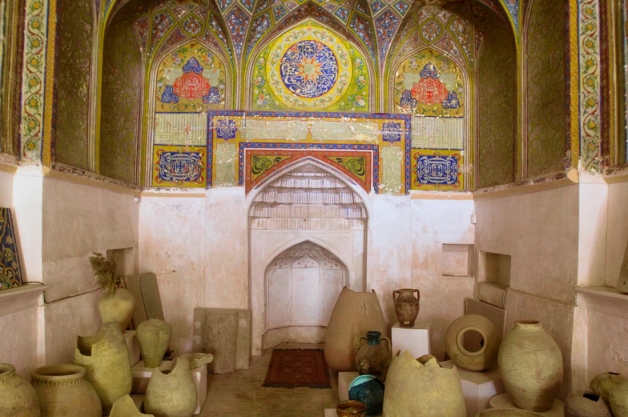Bukhara State Museum-Preserve
Bukhara State Museum-Preserve was founded on November 8, 1922. It is one of the oldest museums of Bukhara. In 1945 the museum changed its location to the Ark Fortress, the winter residence of the Emirs located at 2 Afrasiab Street, Registan Square. In 1985, the Bukhara Museum became a state reserve. With 6 branches and 17 permanent exhibitions at various Bukhara's historical sites, Ark of Bukhara remains its central representation.
The collection of Bukhara museum is represented by 100 000 exhibits of tangible and cultural heritage of Uzbekistan. The main part of Bukhara Museum's exposition is made up of exhibits belonging to Emirs of Bukhara from the Mangytes dynasty who ruled during the last centuries.
The vast collection is divided into the several sections:
Bukhara Museum exhibit in Ark:
• History Department - from the beginning of time to the 20th century
• Numismatic Department
• Epigraphic Department
• Nature Department
• Department of Letters
• Department of Contemporary History and Ethnography
An impressive collection of Central Asian arts and crafts is on display at the Sitora-i Mokhi Khosa branch, the summer residence of the Emirs in the Bukhara suburbs (Mokhi Khosa village):
• The household items and luxuries of palace life
• Jewelry
• Paintings, graphics, and sculpture
• Pieces of work of gold embroidery craftspeople
• Copper embossing and blacksmiths
• Wood and ganch carving
• Decorative items used in architecture
The Bukhara Memorial House of the prominent statesman Fayzulla Khojaev, located at 70, Tukaya Street, has valuable exhibits as well. It displays household items of the everyday life of a wealthy merchant family of the 19th century.
Kukeldash Madrasah, built in 1578, preserves articles of literary creation and political activity of historical value such as manuscripts, documents, books, and maps. Here, as well as at the Memorial Museum of Abdurauf Fitrat on Naqshbandi Street, in the hujra, one can learn about the heritage of the Jadid movement and its prominent figures Sadriddin Aini and Jalol Ikrami. It is located at 91 Mehtar Ambar Street as part of the Lyab-i Hauz Ensemble.
In the 17th-century khanaka (dervish lodge) of Nadir Divan Begi, included in the Lyab-i Hauz Уnsemble, there is a trade exhibition of modern handicrafts and decorative arts of Central Asia.
The Magok-i-Attari Mosque on Naqshband Street hosts a carpet museum as a collection of masterpieces of carpet-weaving art, for which the Orient has been famous since the times of the Great Silk Road. In addition to Central Asian soft-pile and colorfully patterned carpets, the best examples of the Armenian and Iranian schools from the last two centuries are displayed here as well.
In the 12th-century mausoleum Chashma-Ayub, the Museum of Water reveals the intricacies of water supply in Bukhara and the old devices used for this purpose such as ceramic pipes, leather waterpipes, and copper vessels. It is located in the Samonids Recreation Park near the dekhkan bazaar.
The composition at the zindan (former Emir's prison) reflects the system of judicial proceedings of the 19th-20th centuries. Bukhara Museum is located at 2 Balimanov Street.
The biographical exposition about the prominent Islamic theologist Imam al-Bukhari will provide an informative journey with a full immersion in the historical era despite that the facility was built for this purpose in 2001 by architect Klichev.
Interesting historical artifacts are located at 41 Nakshband Street in the cultural and memorial complex dedicated to the famous founder of the Sufi order of tariqa - Bahouddin Nakshbandi (Baha' al-Din Naqshband). Address: Kagan District, Kasri Orifon village.
A collection of the best samples of Bukhara craftsmanship is on display at the Art Wood Museum located in Abdulaziz-Khan Madrasah at 22 Khoja Nurobod Street.
Ulugbek Madrasah is an architectural preservation museum with an exhibit on the reconstruction of historical monuments in the Bukhara oasis highlighting the finer points of the restoration work carried out in the region since the early 20th century. It is located at 33 Khoja Nurobod Street near Zargaron Dome.
The blacksmith museum of the 16th century at Kulyut Caravanserai near the second commercial dome of Toki Telpak Furushon at 12 Hakikat Street shows not only the history of the craft but also allows you to try your hand at making your creation under the guidance of the famous blacksmith usto Shirin Kamalov.
Ibrahim Ohund Madrasah demonstrates an exposition about the legendary ancient town of Varakhsha, which used to be located on this land (177 Mehtar Anbar Street, Zhondor District) in the 4th-7th centuries AD. Varakhsha was the capital of the Sogdian dynasty of Bukhar Khudahs.
The history of jewelry and fine arts from the 1st to the 20th century is represented by a permanent exhibit at the Art Museum after Kamoliddin Behzod.
Poykent is a large ancient settlement of Sogd, located 60 km from Bukhara, previously referred to as the "city of merchants." Only ruins have survived to our days, and for the sake of their preservation Poykent History Museum has been established.
The museum in the Ashfana village in the Peshkun District near Bukhara is dedicated to the life of the great medieval scientist, mathematician, poet, musician, philosopher, and physician Abu Ali Hussein Ibn-Abdallah Ibn-Ali Ibn-Sina known in the West as Avicenna. Ibn Sina was the most famous philosopher of the Muslim world and served as court vizier of the Samanid dynasty and Persian Deylemite. He wrote 450 works in 29 scientific fields, and only a bit more than half of them have survived to the present day. The museum was built in 1980, in honor of the 1000th anniversary of his bright mark in history.
Romitan Museum of Local Lore is located in Bukhara Region, in the town of the same name at 17 Yakhshi Navruzov Street, 17 km northeast of Bukhara. Romitan town was founded before Arabs came to these lands. It used to be the winter residence of the Emirs of Bukhara. The town was first mentioned in written sources in the 10th century. Romitan is famous for its honorable native - in 1195, Khoja Ali Ramitani, one of the most famous masters of Sufi tariqat of "Hajagan," was born here.
Operating hours: from 9.00 to 16.30, Tuesday: from 9.00 to 14.30, closed on Wednesday.









